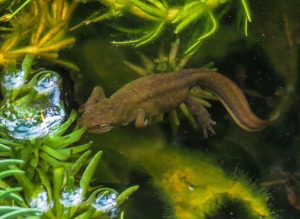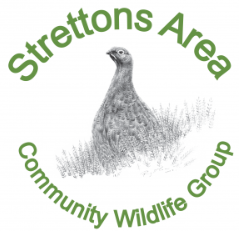

On 15 October 2025 the Strettons Area Community Wildlife Group hosted an evening event at the Church Stretton library to present the findings from the Garden Wildlife Survey 2025 and suggest some gardening tips for wildlife. After the presentation guests were invited to enjoy cheese and wine, chat about wildlife gardening, and share any further ideas to help our wildlife thrive.
The garden wildlife survey had 119 respondents, several of whom reside outside of the parish. Most people (97%) reported that they garden with wildlife in mind, 50% stating that wildlife is a priority. The findings show a diversity of habitats including wildflower areas and long grass, mixed tree and hedgerow species, as well as water features such as ponds. All of which create a variety of places that birds, mammals, amphibians and reptiles, and insects, can shelter and feed.
A wide range of mammal species were recorded, with occasional sightings of foxes, badgers, bats, otters, and polecats. Hedgehogs were found in 39% of gardens, spread across the Strettons. Frogs, toads and newts were present in over two thirds of the gardens (64%) and this corresponded with the number of water features (63% of gardens have ponds). Slow worms were also sighted in a quarter of the gardens. Most respondents said they also had nesting birds.
Wildlife garden tips shared with the audience were varied. A mixed species hedgerow that is left uncut until the end of the bird nesting season (end of August) is a simple measure. Or plant a native tree(s) that has blossom and berries, such as hawthorn or rowan. Creating a dead hedge with your woody prunings provides habitats for all sorts of creatures. As it rots down nutrients are recycled back into your garden. A simple brash or log pile will also create a place for hedgehogs and amphibians to shelter as well as an overwintering space for insects. Leaving an area of grass longer or planting wildflowers means birds have a natural source of food, particularly during late summer/autumn as the seed heads form. A must in all gardens is provision of water for wildlife. If you don’t have a pond, a bowl with a few pebbles in it to allow insects and small birds and mammals to climb onto gives them access to fresh water. Change the water and clean the bowl regularly.
Next month read about the findings for the invertebrates, and more hints and tips to help garden wildlife. In the meantime, here are some ideas for Christmas presents if you aren’t sure what to buy a loved one: bird and/or bat boxes, hedgehog house, bug house, a native tree suitable for a garden. The pleasure will last long after Christmas.
Photo Credits: Peter and Janet Howsam
For more information on any of this please email: SACWG_Chair@shropscwgs.org.uk.
